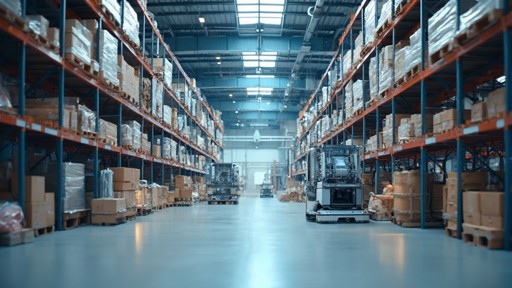Introduction
Supply chain automation is revolutionizing business operations by harnessing cutting-edge technology. By integrating AI, ML, and IoT, companies can automate routine tasks, leading to enhanced efficiency, reduced errors, and increased visibility. The importance of supply chain visibility cannot be overstated.
It allows for real-time tracking and monitoring of products, materials, and information, enabling better decision-making processes. Europris, Norway’s leading retailer, consolidated six warehouses into one automated logistics center, showcasing the benefits of a well-executed automation strategy. AI and ML are now necessities, offering holistic solutions to enhance efficiency and decision-making.
The transformative role of technology is supported by a survey that highlights the predicted 20-25% increase in cash flow for companies that fully embrace AI. The transition to automated supply chain systems promises not only immediate improvements but also a robust framework for sustainable growth and customer satisfaction.
What is Supply Chain Automation?
Using the potential of advanced technology, automation in business operations is transforming the way companies manage their activities. By incorporating artificial intelligence (AI), machine learning (ML), and the Internet of Things (IoT), organizations can automate everyday and repetitive tasks, resulting in a substantial improvement in productivity, a notable decrease in mistakes, and a boost in transparency throughout the entire business network. This technological leap forward is not only beneficial for the internal workings of a business but also plays a pivotal role in delivering superior customer experiences.
The significance of visibility in the flow of products and services cannot be exaggerated. It is the cornerstone that ensures the smooth tracking and monitoring of products, materials, and information through every stage of the supply chain. From the procurement of raw materials to the delivery of final products to customers, visibility is achieved by gathering and analyzing real-time data, which informs the movement, location, and status of goods. This level of insight is invaluable for enhancing decision-making processes, especially when numerous variables are at play.
Take, for example, the case of Europris, Norway’s leading discount retailer. Their journey towards mechanization involved consolidating six warehouses into one automated logistics center. The project, executed in multiple phases over six years, exemplifies how a well-planned and executed automation strategy can lead to increased efficiency and future growth.
In the domain of logistics management, AI and ML are no longer just choices but requirements for businesses seeking to stay ahead. These technologies have been instrumental in understanding complex relationships between variables and improving operational outcomes. As industries struggle with disruptions in the flow of goods, AI and ML emerge as potential game-changers, offering comprehensive solutions to improve efficiency and decision-making.
In addition, a survey by Blue Yonder emphasizes the feelings of more than 600 C-suite and senior executives who emphasize the game-changing role of technology in logistics. They imagine a future where logistics strategy is influenced by advanced intelligence, resulting in a projected 20-25% rise in cash flow for companies that fully embrace AI.
In summary, the transition to automated supply logistics systems is a strategic move that promises not only immediate operational improvements but also a robust framework for sustainable growth and customer satisfaction.
Benefits of Supply Chain Automation
Supply chain mechanization stands as a transformative force, redefining the efficiency and effectiveness of business operations. Following the example of Europris, the main discount retailer in Norway, the merging of six warehouses into one, fully automated logistics center showcases the notable enhancements that can be achieved through the use of advanced technology. The Europris journey with Swisslog, developing a highly efficient warehouse with 65,000 pallet locations and advanced Vectura pallet cranes, underscores the tangible benefits technology brings to the table.
- Efficient Processes and Increased Productivity: By embracing streamlined operations, businesses like Europris have eliminated the tedium of manual tasks, thereby enabling their workforce to engage in value-adding activities. This shift has been quantified by SCALA’s industry research, which reports that 66% of companies experience enhanced productivity post-automation.
The visibility that technology brings can not be overstated. It allows for minute-to-minute tracking of inventory and shipments, providing a clear picture of the supply chain and enabling companies to swiftly address any arising issues, as seen in Europris’ modern warehouse operations.
- Accuracy and Cost-Effectiveness: Human error is significantly reduced with mechanization. For example, the careful nature of automated systems in information entry and inventory management ensures consistency and accuracy, which, according to SCALA, leads to cost savings for 62% of businesses.
- Accelerated Delivery and Reduced Lead Times: Automation directly contributes to faster operational processes, trimming down lead times and meeting the swift pace of customer demands. The seamless operation of Europris’s automated warehouse is a testament to how rapidly goods can be moved and managed, directly contributing to customer satisfaction and loyalty.
In today’s complex regulatory landscape, the use of technology serves as a reliable ally in maintaining compliance with industry standards, ensuring the integrity of information, and facilitating audits. The meticulous records and data accuracy intrinsic to automated systems reduce the risk of costly non-compliance issues.
In view of economic uncertainties, companies may have reservations about the upfront investment in mechanization. However, the broader impact on business revenue and growth, as highlighted by 66% of businesses citing their ability to better meet customer demands, makes a compelling case for considering such advancements. The journey of Europris demonstrates that with a strategic, phased approach to automation, companies can realize a future-proof operation that is not only efficient but also resilient in the face of industry challenges.
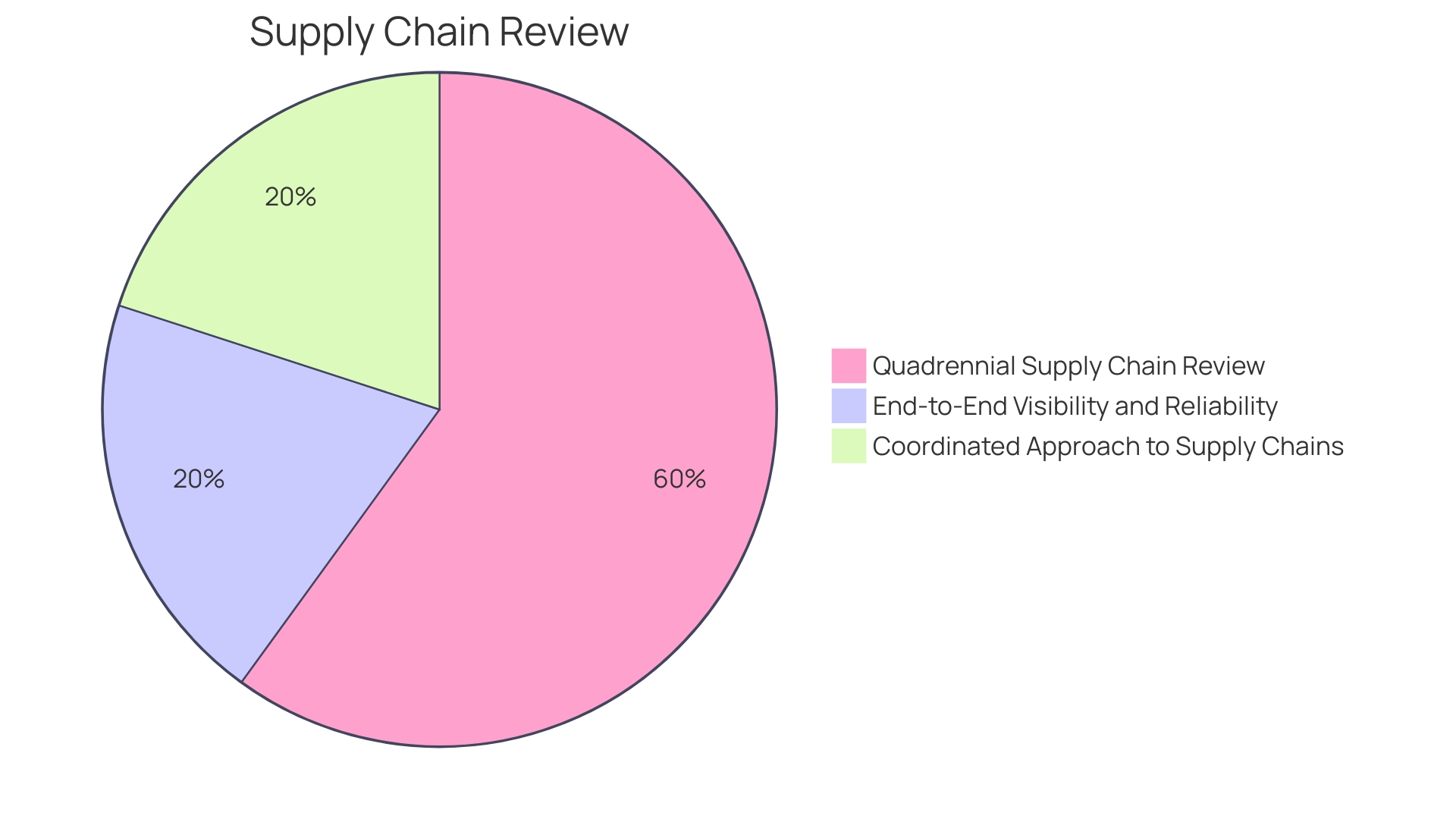
Key Technologies in Supply Chain Automation
Optimizing the supply chain is a multifaceted endeavor, involving a cadre of technologies that synergize to enhance efficiency and effectiveness. At the forefront is Artificial Intelligence (AI), which endows systems with the capability to analyze information, predict outcomes, and make informed decisions. This empowers companies to foresee market demands, maintain equipment proactively, and determine the most efficient routes for transportation.
Machine Learning (ML), a subset of AI, employs algorithms that learn from information to enhance performance over time. This is crucial for forecasting demand patterns, detecting deviations, and optimizing delivery routes, thus improving efficiency of operations.
Next, the Internet of Things (IoT) plays a pivotal role by bridging the gap between the digital and physical realms. Sensors and devices gather real-time information, offering vital insights on inventory levels, machinery conditions, and overall supply chain status. This information is vital for proactive upkeep, asset tracking, and real-time monitoring.
Robotic Process Automation (RPA) simplifies routine, rule-based tasks by emulating human actions. It’s particularly useful for information input, order processing, and validating invoices, freeing human labor for more complex tasks.
Lastly, Blockchain technology fosters a secure and transparent environment for transactions within the supply chain. It ensures product authenticity, traces origins, and maintains information integrity.
Real-world applications of these technologies demonstrate their transformative potential. For instance, John Dee Warwick significantly improved operational efficiency by automating processes that were previously manual and cumbersome. Soeren Schauki from Dematic emphasized how advanced technologies have addressed challenges unique to meat processing, such as variability in product release and the need for meticulous tracking.
Furthermore, experts like Roshan Shah from Georgia Pacific highlight the importance of harnessing AI to generate value through data. The adoption of digital tools not only improves operational efficiency but also reshapes entire business models, as seen in industries like retail, where digital transformation is central to providing seamless customer experiences.
To sum up, through the integration of AI, ML, IoT, RPA, and Blockchain, businesses can address the intricacies of the contemporary distribution network, attaining unmatched transparency, flexibility, and effectiveness.
Business Examples of Supply Chain Automation
Exploring the transformative realm of supply chain mechanization, we discover compelling business examples that demonstrate the efficacy of these technologies in action. Automated Inventory Management systems are revolutionizing the way businesses handle their stock. By integrating IoT sensors with advanced AI for demand forecasting, companies can maintain optimal inventory levels, sharply decrease instances of stockouts, and significantly cut down on holding costs.
Intelligent Warehouse Operations are a testament to the capability of technology to refine efficiency. With the deployment of robotics, warehouses are witnessing a new era where Automated Guided Vehicles (AGVs) and robots are assuming responsibilities such as picking, sorting, and packing. This not only trims down the need for manual labor but also escalates the speed and accuracy of operations.
The concept of Predictive Maintenance is being brought to life with IoT sensors and predictive analytics. These tools provide businesses with the power to preemptively address maintenance needs. By harnessing real-time information from machinery and equipment, companies can anticipate potential failures, strategically schedule maintenance, and evade expensive downtimes.
Moreover, Smart Transportation and Logistics are being redefined by automation. GPS tracking systems, route optimization algorithms, and real-time data analytics are converging to refine the transportation and logistical aspects of business. This integration leads to route optimization, reduced fuel consumption, and heightened precision in deliveries.
To illustrate the impact of such technologies, let’s consider Europris, a leading Norwegian discount goods chain. The company began a ambitious journey towards mechanization, consolidating six warehouses into a single, efficient, automated logistics center. This was achieved through a phased approach, culminating in an advanced setup featuring an automated pallet warehouse with 65,000 pallet locations and 11 Vectura pallet cranes.
In similar strides, the global corporation Amazon is embracing the use of technology by investing in technologies like Digit for package handling and Sequoia for sorting inventory. Such innovations are propelling the company towards greater operational efficiency in their warehouses.
These examples highlight the wider pattern of logistics robots becoming more and more sought after. The automation market is expanding briskly, with forecasts indicating robot shipments could surge by 50 percent annually through 2030. This expansion is driven by the acknowledged requirement for robust distribution networks that can overcome labor difficulties, improve the quality and safety of fulfillment, optimize space, and increase throughput.
As industries struggle with the consequences of global disruptions in the flow of goods, the implementation of AI and ML solutions is proving to be extremely valuable. These technologies are not just enhancing efficiency but are also uncovering previously unknown relationships between variables, allowing for more informed decision-making processes.
To sum up, the progress of streamlining the movement of goods and services is not just about embracing new technologies; it’s about incorporating these solutions in a way that addresses specific business needs, acknowledges trade-offs, and allows for scalability. The path towards a highly automated supply network is intricate, but as these instances demonstrate, it’s an endeavor that can produce significant advantages for those prepared to navigate its trajectory.
How Supply Chain Automation Improves Operations
Supply chain mechanization is revolutionizing the way businesses manage their operations, providing a myriad of benefits that drive efficiency and productivity. By implementing automation, companies can remove the burden of manual and repetitive tasks, allowing employees to concentrate on higher-value activities. For example, this can involve analysis of information, strategic decision-making, and fostering connections with suppliers and customers.
One of the main benefits is the improvement of accuracy and quality. Automation reduces the risk of human error, ensuring data is consistent and reliable—a critical factor for informed decision-making and maintaining smooth operations. Streamlining workflows and processes is another significant benefit. Automation helps eliminate bottlenecks, shorten cycle times, and facilitate seamless cooperation across various departments, thereby bolstering communication and coordination.
Furthermore, the use of technology provides immediate insight into important aspects like stock levels, order statuses, and tracking of shipments, enabling businesses to proactively oversee their supply networks, promptly detect issues, and execute timely remedies. Additionally, advanced tools like demand forecasting algorithms and inventory optimization models offer substantial improvements in inventory management. This ensures optimal stock levels, minimizes the risk of stockouts, cuts holding costs, and elevates customer satisfaction.
Case studies, like Europris in Norway, demonstrate the revolutionary potential of mechanization. The top discount store for daily products started a multi-phased automation process that resulted in the consolidation of six warehouses into one automated logistics center, greatly improving their operational efficiency. This comprehensive approach included a thorough analysis of current business needs, future requirements, and the creation of a tailored design level, showcasing the importance of a strategic and phased implementation.
In the present environment, AI simulation platforms are proving essential for managers responsible for the flow of goods, enabling them to navigate complexities and gain visibility into the potential impact of decisions on overall performance. According to Michel Morvan, Co-founder and Executive Chairman of Cosmo Tech, this technology helps to anticipate different futures and overcome important barriers, thereby providing a competitive advantage in global distribution networks.
By adopting automation and AI tools in the management of logistics, companies can effectively tackle common obstacles and foresee what lies ahead, enabling them to make strategic changes to enhance their ability to withstand disruptions and promote environmental responsibility. This approach has been proven by industry leaders who rely on these technologies to manage intricate supplier networks and complex decision-making processes.
Reducing Errors and Operational Costs
Streamlining supply chain operations is not just a goal, it’s a necessity for businesses looking to thrive in a competitive market. By leveraging the power of Robotic Process Automation (RPA), companies are able to automate repetitive tasks like information input and invoice processing, which in turn reduces human error and enhances overall operational efficiency.
AI and machine learning are revolutionizing the way businesses forecast demand and manage inventory. With predictive analytics, companies can anticipate market trends, optimize stock levels, and minimize the costly errors associated with under or overstocking. For instance, the use of sophisticated AI algorithms allows for a deep dive into historical data, revealing patterns that can inform smarter business decisions.
Quality control is another area where mechanization can make a significant impact. Automated systems provide consistent oversight in manufacturing, quickly identifying defects or compliance issues. This proactive approach to quality assurance not only prevents expensive errors but also enhances customer satisfaction by ensuring product reliability.
Investment in employee training and education is a crucial strategy for reducing errors. When workers are well-informed about the latest technological tools, they are less likely to make mistakes stemming from misunderstandings or a lack of knowledge. This not only improves efficiency but also empowers the workforce.
Europris, Norway’s premier discount retailer for everyday products, offers a tangible example of successful streamlining in the movement of goods. They started a multi-phase process, starting with the consolidation of six warehouses into one automated logistics center. The project involved meticulous planning, from initial analysis and design to the development of tailored solutions. The result was an automated pallet warehouse with 65,000 pallet locations and 11 Vectura pallet cranes, demonstrating the transformative power of logistics automation.
In today’s fast-paced world, keeping up with the latest advancements in logistics technology is crucial. The incorporation of AI and ML into distribution networks is no longer a futuristic concept but a present-day reality, offering a beacon of hope for industries struggling with efficiency challenges. The rise of ESG investments reflects a growing consumer preference for sustainable and responsibly sourced products, further emphasizing the need for businesses to adapt and innovate. With the ongoing advancement of technology, networks of distribution are becoming more robust and ready for the demands of the future.
Faster Fulfillment and Lead Times
Utilizing the power of supply chain mechanization gives a competitive advantage in today’s fast-paced market. By embracing digital transformation, companies can significantly cut down on lead times and elevate their fulfillment processes.
- Streamlining order processing is a game-changer for businesses aiming for precision and efficiency. Utilizing Robotic Process Automation (RPA), for example, minimizes human error and heightens order accuracy, paving the way for a smoother fulfillment trajectory and expedited order handling.
- The integration of robotics and advanced technology within warehouse operations catalyzes the efficiency of picking, sorting, and packaging workflows. This advancement not only trims down cycle times but also propels quicker order fulfillment, as evidenced by companies like John Dee, who underwent a tailored multi-stage upgrade journey to refine their material flows and operational design.
- Leveraging real-time analytics is a strategic move that allows for vigilant monitoring of inventory levels, demand patterns, and consumer preferences. This vigilant approach to data analysis facilitates prompt inventory replenishment and swift responses to customer orders, as highlighted by the ambitions of Rivian, an electric vehicle manufacturer, to achieve net-zero emissions and streamline their global operations.
- Advanced tools offer route optimization capabilities, considering various factors such as distance, traffic conditions, and delivery schedules. Opting for the most efficient pathways, companies can diminish transit times and boost overall delivery velocity.
Incorporating these automation strategies not only enhances the operational excellence of a business but also aligns with the progressive evolution towards digitized logistics. As Robert Lawrence, a freelance writer, notes, the era of digitization has arrived with 91% of businesses engaging in digital initiatives. McKinsey analysts further support this by revealing that companies which digitalize can experience a 2.3% increase in annual revenue growth and a 3.2% increase in annual earnings growth.
In the end, the process of incorporating these technologies into operations related to the movement of goods is proof of an organization’s dedication to innovation, sustainability, and customer contentment.
Better Visibility and Security
Automation in logistics management is revolutionizing how businesses operate by offering unprecedented levels of visibility and security. Here’s how:
- Real-time Tracking: Leveraging GPS and other tracking technologies, businesses can now monitor the movement of goods with pinpoint accuracy. This live information simplifies the logistics by offering current location updates, guaranteeing openness and allowing prompt reactions to any issues during transportation.
- Protected Information Transfer: With an emphasis on secure communications, advanced tools employ encryption techniques to safeguard sensitive information during its transfer among supply chain collaborators. This includes critical information such as customer details, purchase orders, and financial transactions, safeguarding against unauthorized access and ensuring data integrity.
- Improved Traceability: From the origin of materials to the hands of the end consumer, advanced technology provides a comprehensive view of a product’s journey. This level of detail not only improves traceability but also aids in pinpointing sources of defects or issues, enhancing overall quality control.
- Risk Mitigation: Advanced tools can detect anomalies and potential risks by analyzing patterns and deviations from the norm. Early warnings allow businesses to proactively address issues, minimizing the risk of security breaches or operational disruptions.
These advancements in logistics automation are not just theoretical. A case study by GOCOMET emphasizes that ‘visibility in the logistics network refers to the capability to track and monitor products, materials, and information through all stages of the distribution process.’ This visibility is paramount for companies like John Dee, which implemented a multi-staged upgrade journey that included analysis, design, and the development of alternatives, as described by Soeren.
Moreover, standardized information models, as promoted by the OASIS Open Supplychain Information Modeling (OSIM) Technical Committee, aid in decreasing confusion and inefficiencies in information exchanges, enhancing clarity throughout the logistics network. This is crucial for software and hardware vendors who benefit from clear, standardized data to effectively plan product updates and support.
In the context of security, the importance of starting with a risk-based approach is emphasized, asking critical questions about what needs protection and where vulnerabilities lie. This extensive approach, as outlined in different industry reports, is crucial for strengthening defenses against threats hiding within the shadows of software distribution systems.
By embracing these tools and tactics, businesses are not only safeguarding their distribution networks but also positioning themselves for prosperity in an ever-evolving global market.
Enhancing Productivity and Regulatory Compliance
The transformative power of streamlining the movement of goods and services is evident in increased productivity and enhanced regulatory compliance. By automating processes, businesses can shift their focus from mundane tasks to strategic activities that add significant value. For example, the implementation of advanced technology in supply chains leads to significant reductions in manual labor. This shift allows staff to concentrate on complex tasks that demand human insight, thus fostering a more productive and efficient workflow.
Data accuracy is another area where technology excels, mitigating the risk of errors in critical operations like order processing and inventory management. Accurate information is not just a matter of efficiency; it’s essential for meeting stringent regulatory standards. The introduction of mechanization tools has made real-time data and analytics readily accessible, streamlining the reporting process. This swift and precise reporting is invaluable for compliance with regulatory mandates and bolsters informed decision-making.
Furthermore, mechanization provides an audit-friendly atmosphere by preserving a thorough digital record of all transactions within the logistics network. This secure digital trail simplifies audits and substantiates compliance, substantially reducing the likelihood of incurring penalties for non-compliance.
The experiences of top companies demonstrate the significant effect of streamlining the supply process. Consider Europris, the leading discounted retail company in Norway, which embarked on a successful journey of streamlining with Swisslog. Their venture consolidated six warehouses into a single, efficient logistics center, utilizing an automated pallet warehouse with extensive storage capacity and sophisticated pallet cranes.
In the context of risk management and production optimization, automation plays a pivotal role. By integrating cloud platforms, companies can monitor their logistics more effectively, identifying potential threats and inefficiencies. This enhanced visibility allows for real-time adjustments to production processes, improving output and minimizing waste.
Significantly, the current distribution network environment, characterized by conventional, manual-focused administration, is ready for change. According to experts in the field, digitizing the flow of goods and services is a strategic action that improves visibility, speeds up procedures, and guarantees carefulness. This modern approach is a remedy to the complexities and potential errors associated with conventional methods.
Data highlights the importance of adopting logistics streamlining. With disruptions becoming a regular topic of discussion, the demand for a more resilient and responsive distribution network is loud and clear. Revelations from more than 600 top-level managers demonstrate a joint effort towards approaches and technologies that transform the flow of resources, highlighting the importance of mechanization in the current ever-changing worldwide market.
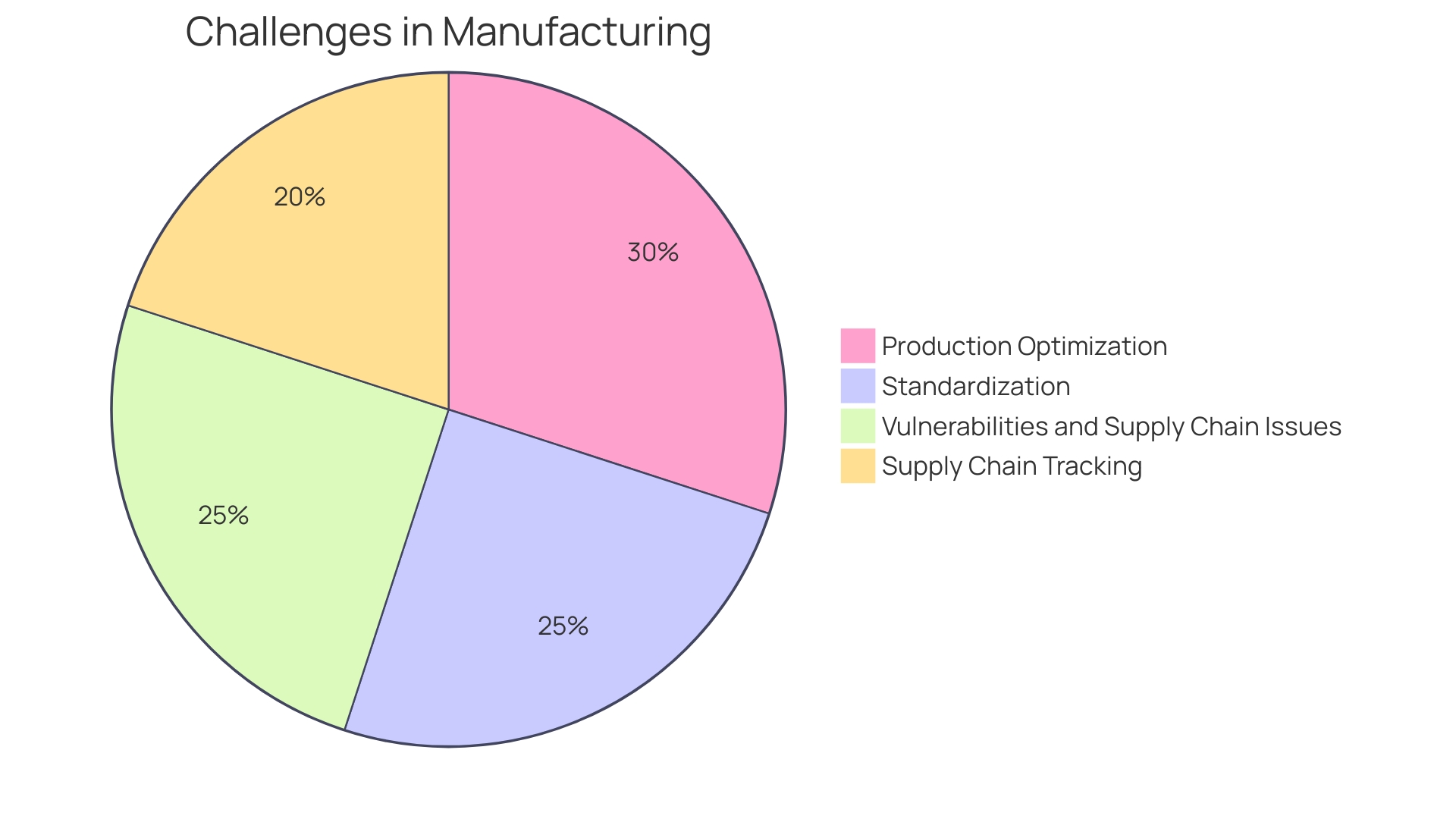
Current Trends in Supply Chain Automation
Supply network digitization is a constantly evolving environment where new innovations emerge to improve effectiveness and meet changing market requirements. Embracing these innovations can provide a competitive edge and address consumers’ increasing desire for sustainability and responsible sourcing. Let’s explore the newest developments influencing the future of logistics improvement.
- Artificial Intelligence (AI) and Machine Learning (ML):
AI and ML technologies are revolutionizing supply chain automation, offering unparalleled analytics and insights. They support demand forecasting, predictive maintenance, and optimize processes, aligning with a growing trend of sustainable practices. Notably, a survey highlighted that a significant 90% of organizations plan to increase their investments in environmental, social, and governance (ESG) criteria within the next few years, responding to regulatory pressures and consumer preferences. - Internet of Things (IoT):
IoT devices are integral to supply chain automation, providing real-time inventory and performance data. Enhanced visibility allows for proactive decision-making, critical in an era where 73% of millennials are willing to pay more for sustainable products. IoT ensures transparency and efficiency, catering to consumer demands for responsible practices. - Blockchain Technology:
Blockchain’s secure and transparent ledger is becoming a staple in supply chain automation. It guarantees product authenticity and tracks provenance, which is crucial as over 80% of consumers are ready to pay a premium for sustainably produced goods. Blockchain fosters trust, an essential component in the sustainable supply chain. - Robotic Process Automation (RPA):
RPA is increasingly employed to automate routine tasks like data entry and invoice processing, enhancing operational efficiency. This move towards mechanization enables human resources to concentrate on more valuable assignments, echoing the viewpoint of industry leaders such as DHL Supply Chain, which emphasizes orchestration, robotics, and AI in their strategic investments.
Additionally, the adoption of Large Language Models (LLMs) like OpenAI’s GPT for tailored analysis and the development of Supply Chain Control Towers exemplify the innovative approaches aimed at real-time issue resolution and enhanced user experiences. With these advancements, the process of managing the flow of goods and services is ready to become more flexible, robust, and in line with the ethical expectations of today’s consumers.
Warehouse Automation and Inventory Management
To optimize supply chains, efficient warehouse operations and effective inventory management are not just advantageous, they’re essential. By embracing technologies such as Warehouse Management Systems (WMS), businesses can revolutionize operations from receiving to shipping, enhancing both efficiency and accuracy.
Robotics and mechanization have emerged as game-changers in warehouse environments, particularly with tasks like picking, sorting, and packing. The introduction of Automated Guided Vehicles (AGVs) and robotic arms transforms repetitive tasks, minimizing manual labor while boosting productivity.
The strategic layout and slotting of a warehouse can significantly shorten travel distances, thus expediting picking and replenishment times and ultimately heightening operational efficiency.
In the realm of inventory tracking, the adoption of Barcode and RFID technologies affords real-time visibility into inventory levels. This level of tracking precision minimizes errors and prevents stockouts.
Moreover, regular cycle counting and ABC analysis are critical for maintaining accurate inventory records. Understanding which items are high-value or move quickly can help maintain optimal stock levels and avert both overstocking and stockouts.
These strategies are not just theoretical. For instance, Europris in Norway offers a real-world success story. By partnering with Swisslog, they consolidated six warehouses into one automated logistics center, which now operates with efficiency and is set for future growth.
Recent industry research highlights the tangible benefits of warehouse mechanization, including heightened productivity, better customer demand fulfillment, and cost savings. Yet, with rapid technological advancements in digital transformation, companies must ensure they choose the right technologies that align with their specific needs and allow for scalability.
The implementation of Automated Storage and Retrieval Systems (AS/RS) also exemplifies the potential of mechanization in streamlining warehouse processes. By reducing the time employees spend walking between locations, AS/RS systems can significantly cut down time waste and enhance efficiency.
With the increase of brands like Movu Robotics, warehouse mechanization is becoming more accessible, promising to meet the surging demand for automated solutions driven by labor shortages and the need for improved profitability and efficiency.
Ultimately, embracing warehouse automation and inventory management technologies is not just about keeping pace with current trends; it’s about future-proofing your business in an increasingly competitive and fast-paced world.
Condition Monitoring and Predictive Analytics
To harness the full potential of condition monitoring and predictive analytics, businesses must embrace a strategic approach that not only anticipates maintenance needs but also enhances asset performance. The implementation process involves a few critical steps:
- IoT Sensor Deployment: Begin by installing IoT sensors to capture real-time performance metrics, such as temperature fluctuations, vibrations, and power usage. This step is crucial for gathering the necessary information to understand the health of your assets. Bosch’s SOFC system, for example, employs a digital twin to monitor process parameters and optimize performance throughout the asset’s lifespan.
- Utilize advanced predictive analytics to analyze the gathered information, identifying patterns and anomalies that may suggest potential failures. Auchan Ukraine’s success in forecasting for a diverse product range across multiple countries showcases the power of predictive analytics in anticipating demand and streamlining operations.
- Integrate predictive maintenance software that works seamlessly with your IoT sensors and analytics to automate processing, issue maintenance alerts, and refine maintenance schedules. This software is a linchpin in converting information into actionable insights.
- Machine Learning Enhancement: Implement machine learning algorithms that evolve with your information, continuously improving their predictive accuracy. Machine learning is pivotal, as it adjusts to new conditions, ensuring predictions remain precise over time. The adoption of machine learning in solar power installations has demonstrated significant improvements in operational efficiency and cost savings.
The predictive maintenance market, now valued at $5.5 billion as of 2022, underscores the growing reliance on these technologies. By following these steps, your business can leverage predictive maintenance to optimize asset performance, mitigate downtime, and achieve considerable cost savings.
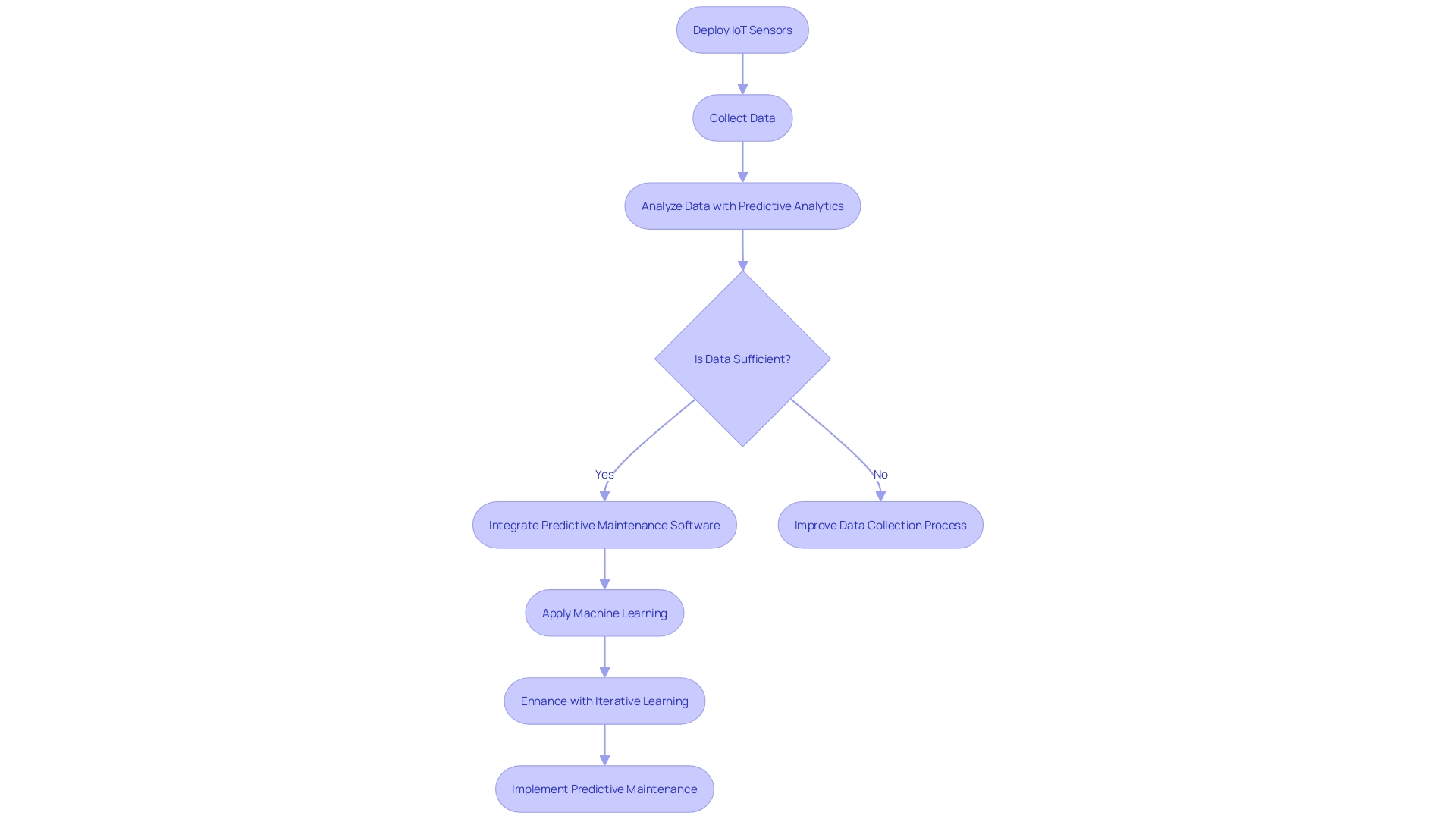
Integration and Interoperability in Supply Chains
To accomplish a seamless and effective flow of goods, it is crucial to concentrate on integration and interoperability. By considering the success of the Capgemini and Kuehne+Nagel partnership, companies can see the real-world impact of strategic collaborations. Adopting an Enterprise Resource Planning (ERP) system can be a game-changer, offering a unified inventory visibility and enabling various functions within an organization to work together seamlessly. Moreover, the use of Application Programming Interfaces (APIs) is critical for allowing different software systems to communicate, which can automate data exchange and enhance interoperability.
Furthermore, employing Electronic Data Interchange (EDI) is a proven strategy for facilitating the electronic exchange of business documents, ensuring accurate and efficient information sharing. Collaboration with third-party logistics providers (3PLs) is another tactic that can yield substantial benefits. Third-party logistics providers with strong integration capabilities can greatly enhance visibility and coordination in logistics operations, optimizing the management of operations and improving customer service.
According to Nate Morrison, the process of transforming digital operations in the realm of logistics extends beyond the realm of technology; it involves the resolution of issues and the facilitation of cohesive interactions between diverse systems. Real-world outcomes from such integrations speak volumes, with improvements in net promoter scores indicating a significant enhancement in customer experience. Moreover, with AI transforming operations for almost all executives, it’s evident that utilizing these technologies is no longer a choice but necessary for future-ready, resilient chains.
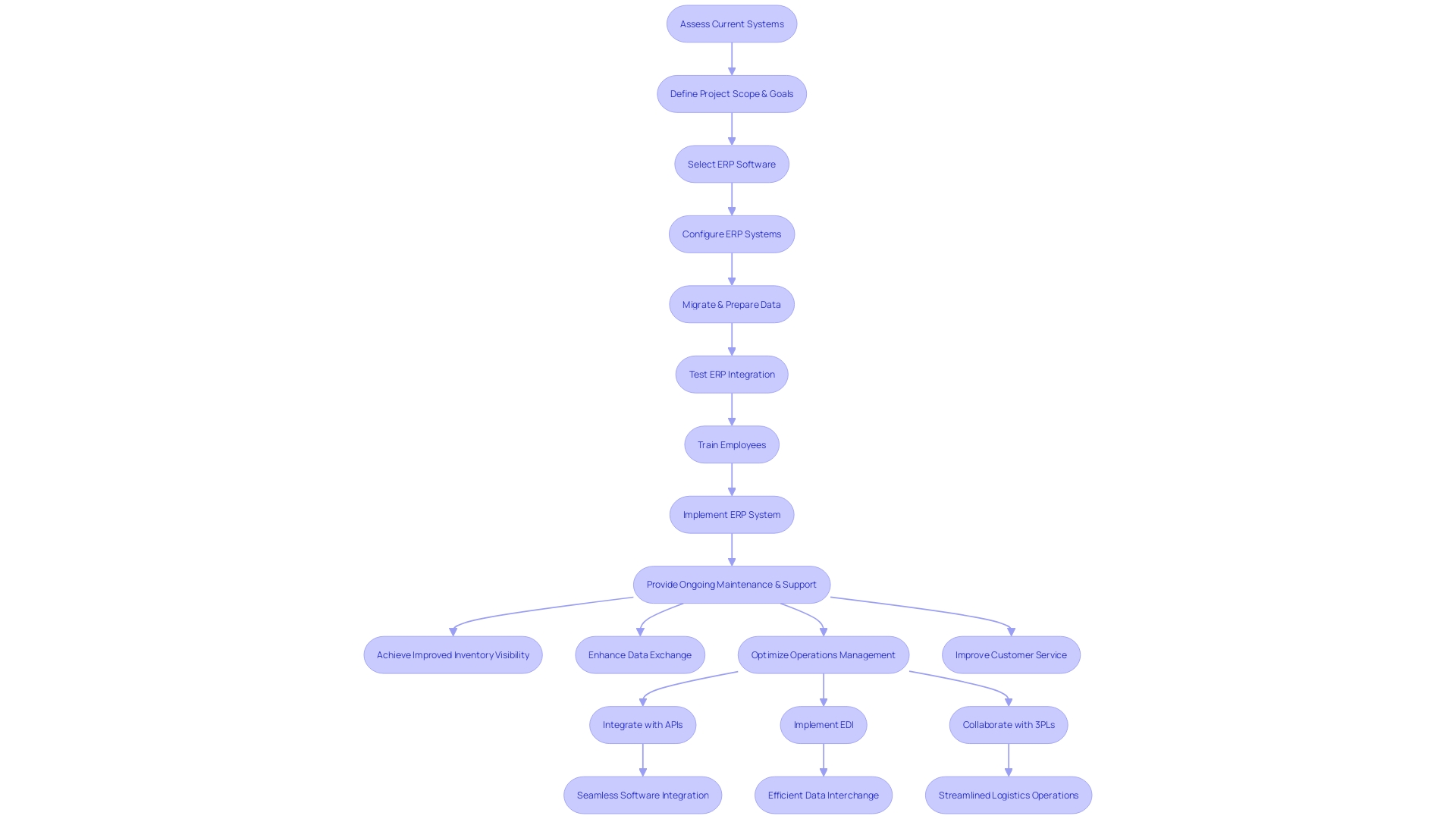
Role of AI, Machine Learning, and IoT in Supply Chain Automation
In the realm of supply chain management, the integration of advanced technologies like artificial intelligence (AI), machine learning (ML), and the Internet of Things (IoT) has been transformative. AI algorithms not only enhance demand forecasting by analyzing patterns in historical information and market trends but also enable companies to maintain optimal inventory levels, minimize stockouts, and elevate customer satisfaction. Meanwhile, ML models utilize sensor information to anticipate when equipment might fail, allowing for proactive maintenance measures that circumvent expensive operational downtime and enhance asset performance. The IoT revolutionizes inventory, asset, and shipment tracking by providing real-time visibility into their location and condition, thereby enhancing logistics transparency and responsiveness. Furthermore, AI and ML are instrumental in analyzing copious amounts of data to pinpoint process bottlenecks, refine workflows, and bolster operational efficiency. These technologies are automating decision-making processes, driving superior outcomes, and reducing costs.
The insightful conversation hosted by Scott Luton and Kevin L. Jackson on Supply Chain Now with Roshan Shah, VP of Applied AI and Products at Georgia-Pacific, sheds light on the power of human-AI collaboration. It underscores how technology empowers personnel rather than replacing them and emphasizes the pivotal role of leadership in managing change within a sizable organization. As industries grapple with logistical challenges, the use of AI and ML has emerged as a promising solution, serving as a ‘silver bullet’ to mend the manufacturing network. These technologies have not only clarified the relationships between various variables and their effects on outcomes but have also unearthed previously hidden correlations.
Given the vulnerability of the interconnected network of resources due to climate change, it is crucial that the flow of goods and services operates efficiently and with a proactive approach. Focused logistics streamlining can result in cost reductions of up to 25% in mid-to-large-sized companies. Furthermore, disruptions can erode up to 45% of a year’s EBITDA each decade, making predictive tools for disruption management not just beneficial but essential for business survival. Certainly, adopting AI and ML in logistics applications is not only about innovation; it’s about maintaining and enhancing operational excellence in a progressively intricate global market.
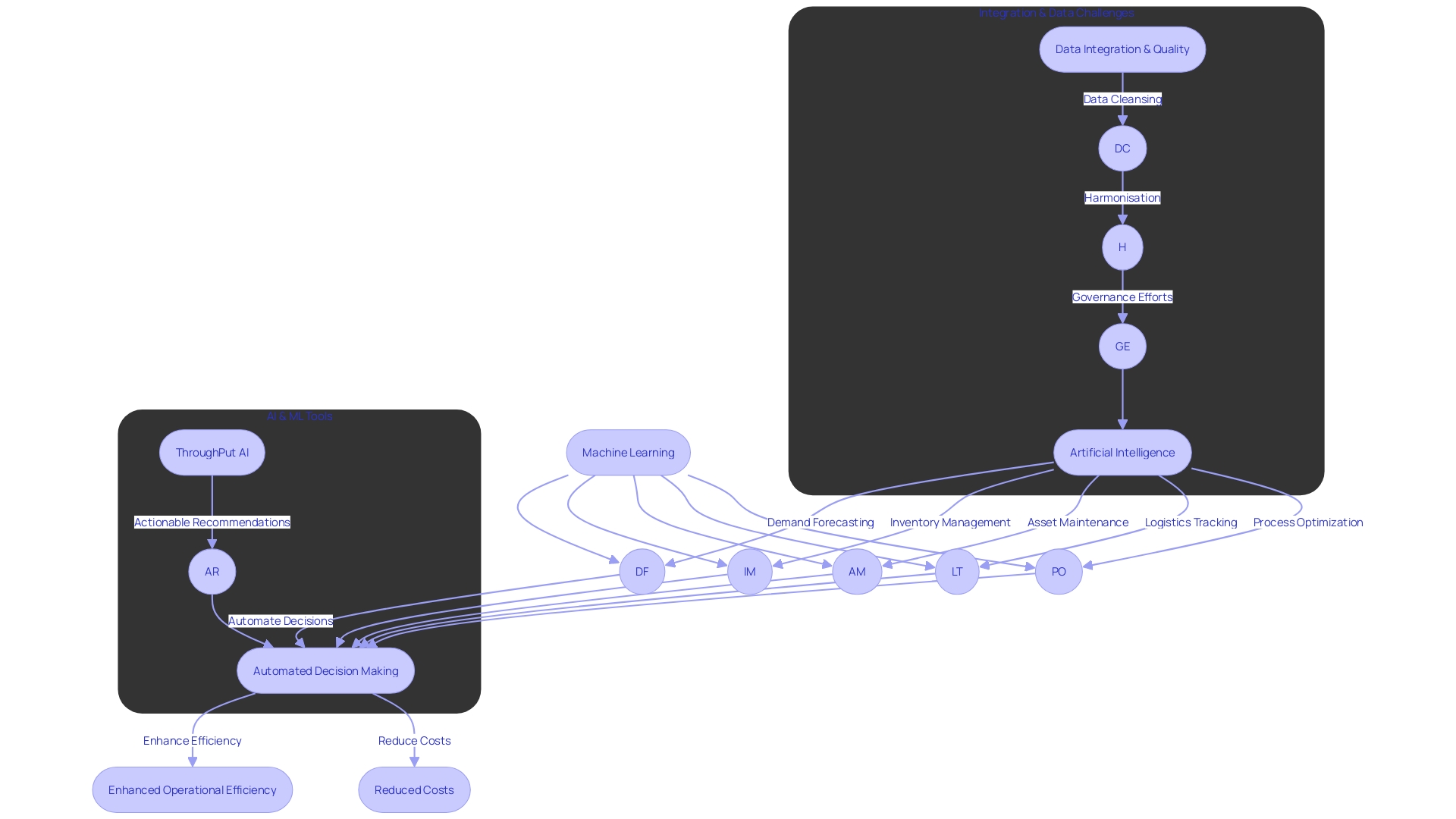
Implementing Supply Chain Automation: Best Practices
To effectively integrate supply chain automation, consider leveraging these key strategies:
- Define clear objectives: Determine specific goals for the implementation of automated processes within your supply chain, identifying the precise tasks that will be mechanized to achieve these objectives.
- Audit Your Processes: Evaluate your current operations thoroughly to highlight inefficiencies and areas needing enhancement. This enables focused efforts that address the most critical needs first.
- Start pilot projects to implement small, manageable processes. This strategy, evidenced by Europris’s phased approach to consolidating six warehouses into a single automated center, enables iterative learning and optimization.
- Involve Stakeholders: Secure buy-in from all stakeholders by involving them from the outset. Their insights and alignment with organizational goals are crucial for a smooth transition to automated processes.
- Choose Experienced Partners: Partner with technology experts who align with your business needs, such as Europris did with Swisslog. Assess their history of success and the support they offer.
- Recognize that the reliability and protection of information is vital to the process of mechanization. Implement strong data governance and use secure systems to protect this valuable asset.
- Training and Change Management: Invest in training to equip your workforce with the necessary skills. Change management is also essential, as seen in John Dee’s multi-staged upgrade journey, to mitigate resistance and encourage adaptability.
- Performance Tracking: Develop KPIs to measure the impact of mechanization. Consistent evaluation of these indicators will shed light on additional opportunities for improvement, ensuring continuous enhancement in your efficiency of providing goods and services.
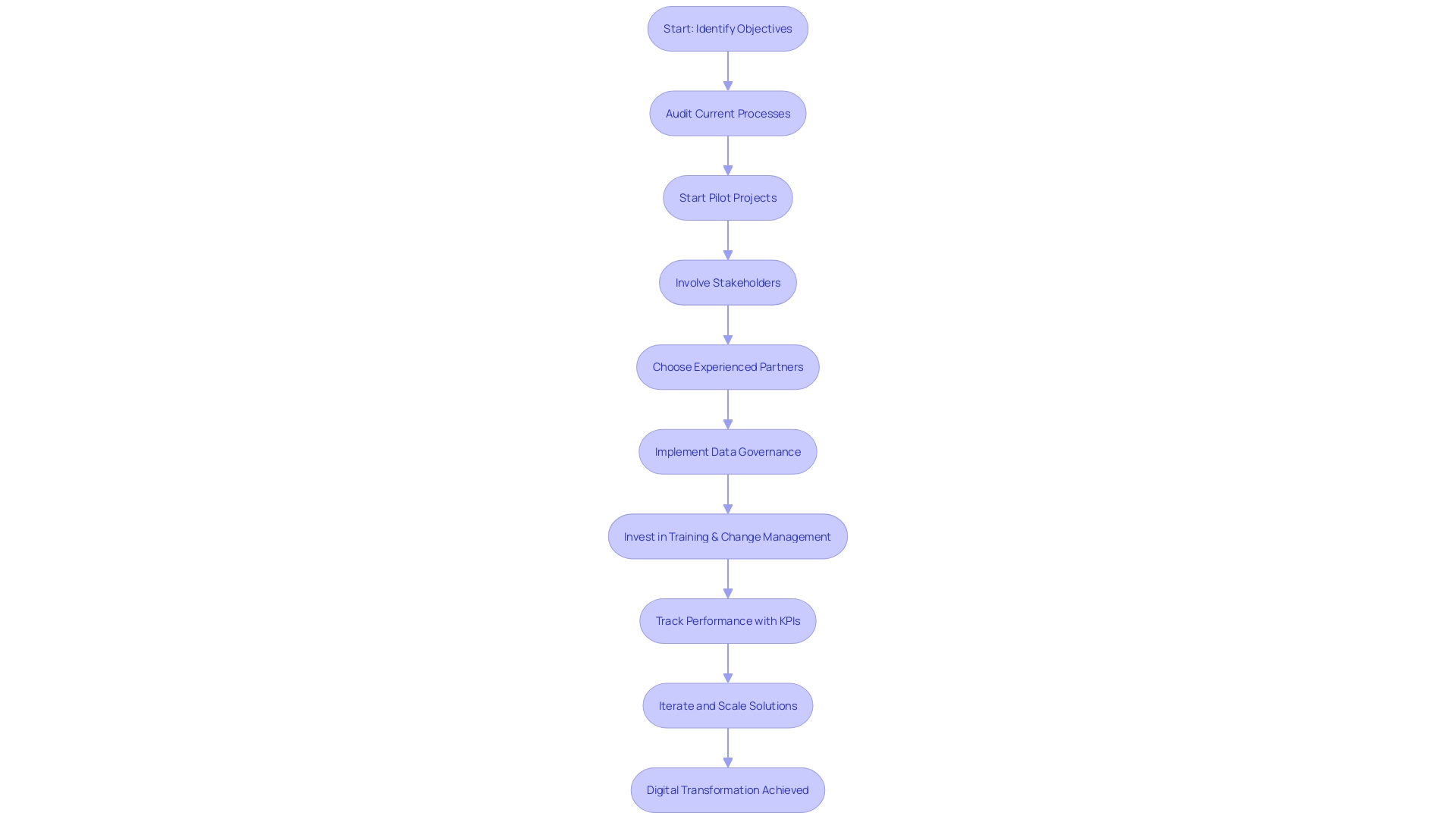
Overcoming Challenges and Ensuring Continuous Improvement
Overcoming obstacles in streamlining logistical processes requires a well-planned method to guarantee ongoing enhancement. Here’s how you can tackle them effectively:
- Change Management: To address resistance to change, it’s crucial to involve employees from the outset. Clearly convey the advantages of automation, such as the potential for supply chain visibility and real-time analysis that can result in improved decision-making. Offer comprehensive training and support to ease the transition, and make sure to celebrate milestones to foster a culture of continuous improvement.
- Integration and standardization of information across different systems is crucial. It ensures that stakeholders can share information effortlessly, which in turn improves accuracy and facilitates better decision-making. This is similar to developing a digital encapsulation of the flow of goods and services, which is the initial stage towards a digital revolution that can generate extra worth.
- Cybersecurity and Data Privacy: Cybersecurity measures cannot be overstated in their importance. Protecting sensitive data and ensuring compliance with regulations is paramount. Regular updates to security protocols and conducting audits to identify vulnerabilities are steps that cannot be skipped in maintaining the integrity of your supply chain.
- Monitoring and Optimization: It’s not sufficient to merely implement mechanization; continuous monitoring of the automated processes is crucial to identify optimization areas. Analytics and reporting tools provide insights for data-driven improvements, reflecting the journey of companies like Europris, Norway, who have successfully completed multi-staged projects.
- The logistics landscape is constantly evolving, influenced by market dynamics, technological advancements, and changing customer demands. Embrace adaptability and flexibility, and be prepared to reassess and adjust strategies regularly to maintain a competitive edge.
Real-World Case Studies and Success Stories
Analyzing the effect of mechanization on distribution networks uncovers convincing tales of triumph that demonstrate its revolutionary capability. Take Company X, which integrated AI and machine learning for precision demand forecasting. This strategic move slashed their inventory costs by 20%, simultaneously maintaining high customer service standards. Then there’s Company Y, which fully embraced state-of-the-art warehouse technology, including robotics and IoT sensors. The outcome was a remarkable 30% drop in picking errors coupled with a 25% boost in the speed of order fulfillment.
Lastly, Company Z focused on enhancing supply chain visibility by integrating data across diverse systems and partners. The result? A striking reduction in lead times by 40% and notable improvements in timely deliveries.
These case studies highlight a significant trend: businesses that make investments in technology can expect to see substantial gains in productivity, efficiency, and customer satisfaction. Industry research supports this, showing that many companies have already made significant investments in warehouse mechanization. The benefits are clear, with increased productivity, the ability to meet customer demand more effectively, and significant cost savings. Despite the high initial costs, the long-term return on investment from implementing automated processes can lead to sustainable growth and a competitive edge in today’s fast-paced market.
In the era where customers demand faster, cost-effective, and flawless service, and companies face escalating costs, mechanization has become a pivotal element for survival. With every dollar needing to deliver a measurable return, the efficiency and profitability gains from automation offer a compelling case for modernizing supply chains. The stark reality is that businesses slow to adopt these technologies risk falling behind in the relentless race of logistics efficiency.
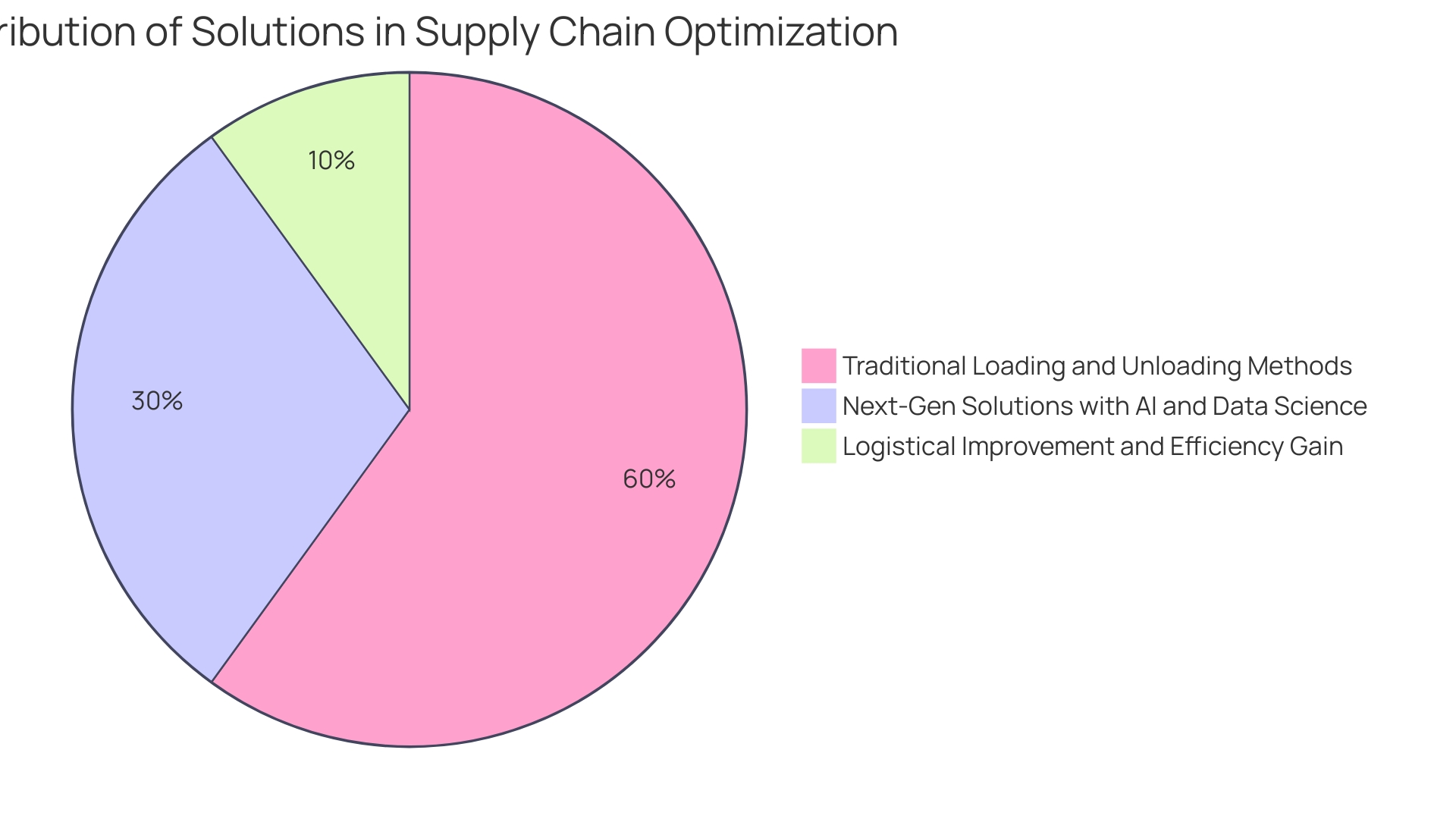
Conclusion
In conclusion, supply chain automation is revolutionizing business operations by integrating AI, ML, and IoT. It enhances efficiency, reduces errors, and improves decision-making processes. Europris, Norway’s leading retailer, showcases the benefits of automation, consolidating six warehouses into one automated logistics center.
AI and ML are necessities, offering holistic solutions to enhance efficiency and decision-making.
Automation brings streamlined processes, elevated productivity, real-time insights, cost-effectiveness, accelerated delivery, and reduced lead times. It ensures compliance and risk mitigation. Key technologies in automation, such as AI, ML, IoT, RPA, and Blockchain, enhance efficiency, transparency, and agility.
Real-world examples demonstrate the power of automation in improving operational excellence.
By reducing errors and operational costs, automation drives efficiency and cost-effectiveness. It optimizes inventory management, enhances quality control, and empowers the workforce through training. Faster fulfillment and lead times are achieved through streamlined order processing, robotics in warehouses, real-time analytics, and route optimization.
Automation enhances visibility and security with real-time tracking, secure data exchange, enhanced traceability, and risk mitigation. It ensures transparency, data integrity, and compliance. Supply chain automation improves productivity, data accuracy, real-time visibility, and proactive management.
Current trends in automation include AI, ML, IoT, and blockchain technologies. These innovations offer unparalleled analytics, insights, and transparency. Warehouse automation and effective inventory management are crucial for streamlining supply chains.
Condition monitoring and predictive analytics optimize asset performance and mitigate downtime.
Integration and interoperability are essential for a smooth supply chain. AI, ML, and IoT play a transformative role, enhancing demand forecasting, inventory management, asset performance, and decision-making. Implementing automation requires precise goals, auditing processes, piloting projects, involving stakeholders, choosing experienced partners, ensuring data integrity and security, providing training, and tracking performance.
Overcoming challenges in automation requires change management, data integration, cybersecurity, monitoring, and adaptability. Real-world case studies demonstrate the transformative potential of automation. In conclusion, supply chain automation is a strategic move that enhances efficiency, reduces errors, and meets the demands of the modern supply chain.
Experience the power of automation and revolutionize your supply chain today.

